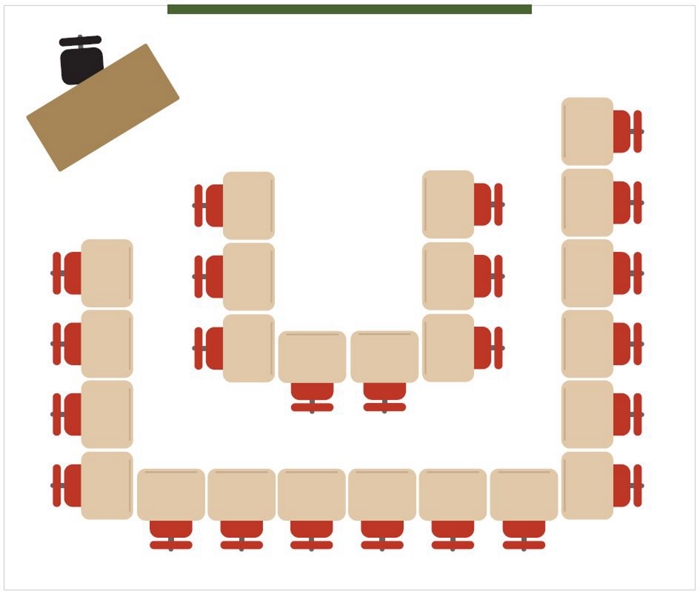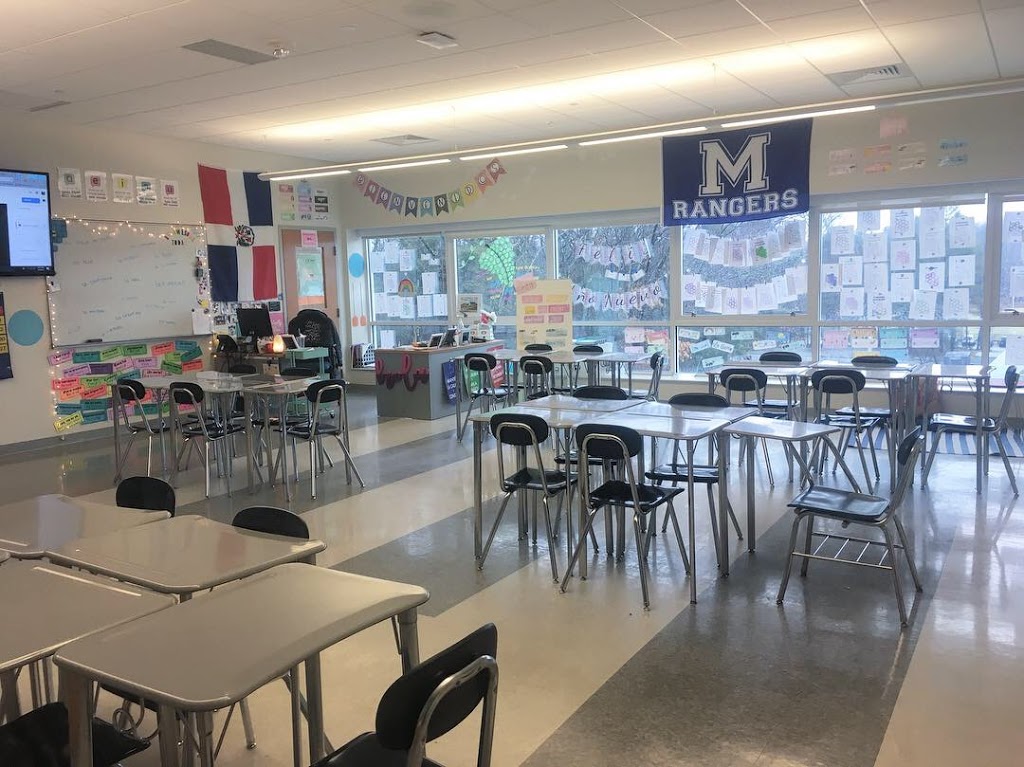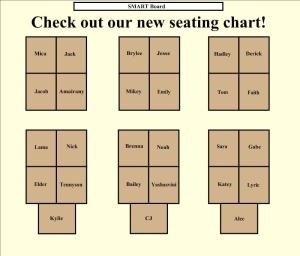
After some trial and error, I have discovered that I am a big fan of group seating arrangements. With classes that often reach up to 32 students, I find that small groups help me to better and more easily manage my interactions with my students as well as their interactions with one another. Below I’ll tell you a bit about why other arrangements didn’t work for me, and why I’ve stuck with small groups for 6 years!
My first year teaching, I asked for advice and I modeled the teachers around me. Some had rows, some had groups, but most had arranged their student desks in a Double U. So I followed suit and utilized the Double U for the year.
My arrangement had a bit more room in the center of the smaller U, but my back row of desks were about as close to the wall as they are in this photo. In my opinion, this arrangement works well for a teacher centered classroom.
It was easy for me to maneuver around the center of the U and support students in the first row. It was also easy for me to make sure I was the center of attention. For my first year teaching, I thought this was great! They’re all paying attention to me! Sweet that must mean they are learning! (Spoiler alert: I was wrong. The teacher being the center of attention does NOT equal better learning outcomes.)

Meanwhile, I soon realized that it was very difficult for me to get to students in the “corners” of the second row. Looking back on this year (8 years ago now), I find myself remembering mostly the faces of the students in the first U. I don’t love that! Was I able to pay enough attention to the second row? And also, I have since learned that I should not be the center of the classroom. It is not about me. It is about my students and they should therefore be the center.
With all of that being said, I should mention that I don’t remember if we kept the same seats all year or if we changed throughout the year. I have a feeling they stayed put. We also didn’t do much movement during class-time throughout the year, simply because it was so difficult to move around the desks. Once students were in their seats, that’s where they stayed. It wasn’t easy to rearrange desks quickly, and the space felt very cramped overall. Again, in my opinion this wasn’t ideal for learning.
I’m not saying that this arrangement can’t work for teachers. If I had a larger space, it may have been a great option for me. But because I personally felt like I couldn’t reach all students easily, because I was the center of attention (instead of students), and because movement was difficult… I know that this arrangement isn’t for me.
My second year teaching, I knew I wanted to try something different. I knew I didn’t want to do rows, but I also hadn’t *loved* the Double U set-up. My second year teaching is also when I had my first class of 30, so I knew I needed to find something that would better support me and my students. I decided to try small groups of 4 and 5, and it quickly became my favorite seating arrangement.

I always have six groups; three groups in front and three groups behind. Depending on the size of my biggest class each year, these groups may have 4-5 desks. If a group only needs 4, I remove the extra desk that sticks out at the end of the group.
Overall, I have 6 groups of 4-5 desks depending on class size each year.
I love these groups for so many reasons!
Here is a photo example I found online: this shows both the groups of 4 and groups of 5.
I often have my groups at an angle, not quite facing directly forward as this chart shows. But you can find what works for you!
I love that this setup offers so many benefits for both myself and the students. I don’t see myself changing anytime soon!

My students love to tell me that I’m the *only* teacher that gives assigned seats. But… they also say that to all of the other teachers I talk to 😉
At the start of the year, I assign seats randomly. I do this before I even meet my students, so sometimes I’ll find that I do have to move a few students within the first week or so. But overall, the random assignment works well for Quarter 1.
At the start of Quarter 2, I will assign new seats. I again choose the seats and students do not, however; I do try to take note of at least one other person that a student enjoys working with. If I know that two students are friends, I will put them together as long as I think they will work productively together. As soon as they prove that they can’t handle it, I quickly move them. I often find myself saying “Keep in mind, once I move your seat you will never be moved back.” This makes them think “Oh crap! I like sitting with him. Shh guys! Focus!”
For Quarter 3, I do the same thing. New seats and new groups, but I try to keep students with at least one person they enjoy working closely with. Keeping them with one friend keeps them happy, and then mixing the groups (quiet/outgoing when I think it will help, or quiet/quiet when I think — or know — that anxiety is involved, and strong/struggling students but mindfully paired, and even sophomores/juniors to help build cross-year relationships) helps me to build these pairs into groups of 4 or 5 that turn into a little community or team. I have had multiple students come into my room as strangers and leave as good friends because of our groupings. Last year, I received a card from a lovely student thanking me for “bringing my best friend into her life,” saying “It’s like I’ve known her forever.” I know this is dramatic and definitely not always the case, but that one example is enough for me to hold onto for now 🙂
For Quarter 4, I allow my students to choose their own seats. I shamelessly use this all year as a bargaining chip. When it’s the start of a new quarter and they’re groaning about their new assigned seats, I say “If you work well for Quarters 1 2 and 3 remember YOU get to choose where you sit for Q4!” And this somehow works. I also remind them to trust me, and I always promise them that I don’t really do random seating. I always put care into the seating chart (one can easily take ma 30 minutes) to make sure that they are somewhere that they will be comfortable.
*Requests*
When students are not satisfied with a new seat, I tell them that I take requests after class for very specific reasons. This request cannot be “I want to sit with ____________.” If they feel that they cannot see from their seat (which is hard with these groups since everyone has a pretty good eyeline of all activities) or they feel they cannot focus for any reason, they can talk to me. I then discreetly make changes without letting students know why I am making the changes. It’s not “Hey! Cory can’t see so we are changing seats!” It might be, “Hey Cory, you’re really good in this unit and Sean was looking for someone to review with. Do you mind if I move you to this group for now?” (Then I never change them back and everyone forgets about it anyways, and Cory is in a new seat where he feels more comfortable.)